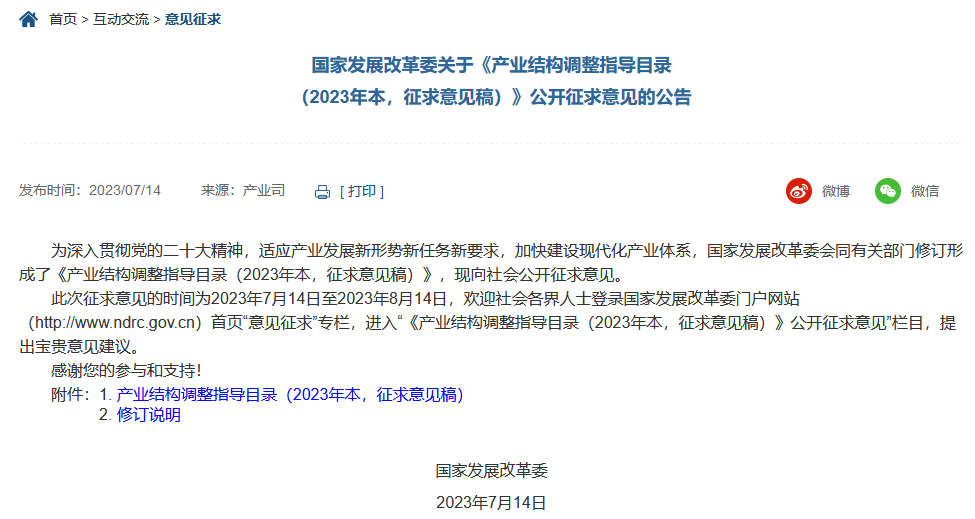Recently, the National Development and Reform Commission and relevant departments have revised and formed the “Industrial Structure Adjustment Guidance Catalog (2023 Edition, Draft for Comment)”, and the time for soliciting opinions is July 14, 2023 until August 14, 2023. The catalog consists of three categories: encouragement, restriction and elimination, among which the encouragement category mainly refers to technologies, equipment and products that have an important role in promoting economic and social development.

Image source: National Development and Reform Commission official website
Encouragement
Agriculture, forestry, animal husbandry and fishery
Comprehensive utilization of renewable resources: comprehensive utilization of crop straws (construction of straw storage and transportation system, straw fertilizer utilization, straw feed utilization, straw energy utilization, straw base material utilization, straw raw material utilization Utilization, etc.), rural renewable resources comprehensive utilization and development projects (biogas project, bio-natural gas project, “comprehensive utilization of renewable resources, biogas power generation, biomass energy clean heating, straw gasification clean energy utilization project, waste mushroom stick utilization, solar energy use).
Power
Electricity consumption and storage: promotion and application of various new energy storage technologies such as electrochemistry, compressed air, flywheel, hydrogen storage (ammonia), heat storage, etc., electric vehicle charging facilities, high-efficiency electric energy replacement technology and Equipment, ship charging and swapping facilities, construction and application of port and ship shore power facilities, and cross-seasonal energy storage technology.
New Energy
1. Wind power generation technology and application: 15MW and above offshore wind turbine technology development and equipment manufacturing, floating offshore wind power technology, plateau and mountainous wind farm construction and equipment manufacturing, offshore wind farm construction It is used in the manufacture of equipment and submarine cables, and the application of rare earth permanent magnet materials in wind power generators.
2. Renewable energy utilization technology and application: solar thermal power generation heat collection system, solar photovoltaic power generation system integration technology development and application, inverter control system development and manufacturing, electrolysis of water to produce hydrogen and carbon dioxide catalytic synthesis of green Methanol, design and manufacture of solar building integrated components, high-efficiency solar water heaters and hot water projects, development and equipment manufacturing of solar medium and high temperature utilization technology, development and equipment manufacturing of ocean energy and geothermal energy utilization technology, development and application of renewable energy heating technology .
3. Biomass power generation technology and application: development and application of non-grain biomass fuel production technologies such as biomass cellulose ethanol, biofuel (diesel, gasoline, aviation kerosene), biomass direct combustion , gasification power generation and cogeneration technology development and equipment manufacturing, agricultural and forestry biomass resources collection, transportation, storage technology development and equipment manufacturing, etc.
4. Hydrogen energy technology and application: efficient and economical hydrogen production, hydrogen transportation and high density.�Cavity high-performance plastic profiles.
3. Film materials: vacuum aluminum plating, silicon oxide spraying, polyvinyl alcohol (PVA) coating film, functional polyester (PET) film, solvent-free lamination or thermal lamination for energy saving New packaging materials such as low-carbon polypropylene film, oriented polystyrene (OPS) film, and paper-plastic-based multilayer composite.
4. New batteries: (lithium iron disulfide, lithium thionyl chloride, etc.), lithium-ion batteries, semi-solid and all-solid lithium batteries, fuel cells, sodium-ion batteries, flow batteries, new Structure (bipolar, lead cloth horizontal, winding type, tubular type, etc.) sealed lead storage battery, lead-carbon battery and other new batteries and super capacitors, lithium-ion batteries with ternary and multi-element, lithium iron phosphate and other positive electrode materials, intermediate phase Anode materials such as carbon microspheres and silicon carbon, single-layer and three-layer composite lithium-ion battery separators, fluoroethylene carbonate (FEC) and other electrolytes and additives, carbon nanotubes, carbon nanotube conductive fluid and other key materials, waste battery resources Modernized and green circular production process and equipment manufacturing, automatic and intelligent production of complete sets of manufacturing equipment for lithium-ion batteries, lead-acid batteries, alkaline zinc-manganese batteries (more than 600 pieces/minute) and other battery products.
Textile
1. Differentiation, functional polyester: continuous copolymerization modification of PET [cation dyeable polyester (CDP, ECDP), alkali-soluble polyester (COPET), high shrinkage polyester (HSPET ), flame retardant polyester, low melting point polyester, non-crystalline polyester, biodegradable polyester, polyester produced by green catalyst, etc.], polytrimethylene terephthalate (PTT), polyethylene naphthalate Alcohol ester (PEN), polybutylene terephthalate (PBT), polycyclohexanedimethanol terephthalate (PCT) and other new polyester and fiber development and production, flame retardant, antistatic, Antibacterial, conductive, phase change energy storage, intelligent temperature control, photochromism, liquid coloring, adsorption and separation, biomedical and other differentiated, efficient and flexible preparation technologies of functional chemical fibers, intelligent, super-simulation and other functional chemistry Fiber production, original development of green, high-efficiency and environment-friendly chemical fiber oil for high-speed spinning processing.
2. Degradable fiber materials: [polybutylene succinate (PBS), polybutylene terephthalate-adipate (PBAT), polycaprolactone (PCL ), poly 3-hydroxyalkanoate (PHA), polylactic acid fiber (PLA), etc.], lyocell staple fiber (more than 50,000 tons of single thread) and lyocell fiber filament, bio-based fiber materials (bamboo, Regenerated cellulose fibers, seaweed fibers, chitosan fibers, animal and plant protein fibers, bio-based polyamides, bio-based polyesters, etc.) made of new renewable resources such as hemp.
3. High-performance fiber: carbon fiber (CF) (tensile strength ≥ 4200MPa, elastic modulus ≥ 230GPa), aramid fiber (AF), polysulfone fiber (PSA), ultra-high molecular weight polyethylene Fiber (UHMWPE) (Single line capacity of spinning production equipment ≥300 tons/year, breaking strength ≥40cN/dtex, initial modulus ≥1800cN/dtex), polyphenylene sulfide fiber (PPS), polyimide fiber (PI) , polytetrafluoroethylene fiber (PTFE), polybenzobisoxazole fiber (PBO), polyarylene oxadiazole fiber (POD), polyether ether ketone fiber (PEEK), poly 2,5-dihydroxy-1, 4-phenylene pyridodiimidazole fiber (PIPD), etc.



 微信扫一扫打赏
微信扫一扫打赏
